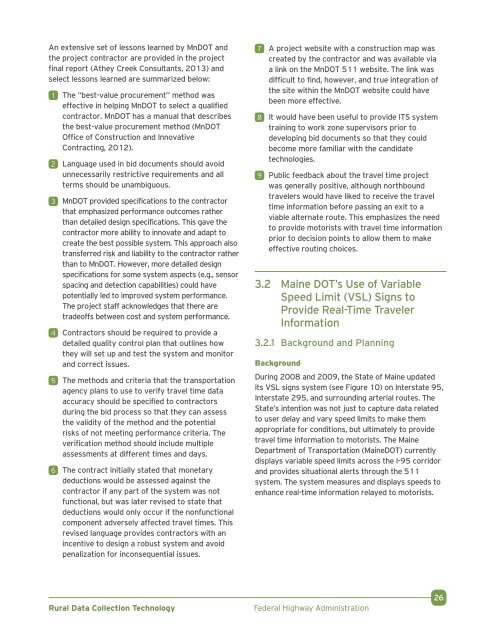Rural Data Collection Technology - FHWA Operations - U.S. ...
Rural Data Collection Technology - FHWA Operations - U.S. ...
Rural Data Collection Technology - FHWA Operations - U.S. ...
- No tags were found...
Create successful ePaper yourself
Turn your PDF publications into a flip-book with our unique Google optimized e-Paper software.
An extensive set of lessons learned by MnDOT andthe project contractor are provided in the projectfinal report (Athey Creek Consultants, 2013) andselect lessons learned are summarized below:1 The “best-value procurement” method waseffective in helping MnDOT to select a qualifiedcontractor. MnDOT has a manual that describesthe best-value procurement method (MnDOTOffice of Construction and Innovative .Contracting, 2012).2 Language used in bid documents should avoidunnecessarily restrictive requirements and allterms should be unambiguous.3 MnDOT provided specifications to the contractorthat emphasized performance outcomes ratherthan detailed design specifications. This gave thecontractor more ability to innovate and adapt tocreate the best possible system. This approach alsotransferred risk and liability to the contractor ratherthan to MnDOT. However, more detailed designspecifications for some system aspects (e.g., sensorspacing and detection capabilities) could havepotentially led to improved system performance.The project staff acknowledges that there aretradeoffs between cost and system performance.4 Contractors should be required to provide adetailed quality control plan that outlines howthey will set up and test the system and monitorand correct issues.5 The methods and criteria that the transportationagency plans to use to verify travel time dataaccuracy should be specified to contractorsduring the bid process so that they can assess .the validity of the method and the potentialrisks of not meeting performance criteria. Theverification method should include multipleassessments at different times and days.6 The contract initially stated that monetarydeductions would be assessed against thecontractor if any part of the system was notfunctional, but was later revised to state thatdeductions would only occur if the nonfunctionalcomponent adversely affected travel times. Thisrevised language provides contractors with anincentive to design a robust system and avoidpenalization for inconsequential issues.7 A project website with a construction map wascreated by the contractor and was available viaa link on the MnDOT 511 website. The link wasdifficult to find, however, and true integration ofthe site within the MnDOT website could havebeen more effective.8 It would have been useful to provide ITS systemtraining to work zone supervisors prior todeveloping bid documents so that they couldbecome more familiar with the candidatetechnologies.9 Public feedback about the travel time projectwas generally positive, although northboundtravelers would have liked to receive the traveltime information before passing an exit to aviable alternate route. This emphasizes the needto provide motorists with travel time informationprior to decision points to allow them to makeeffective routing choices.3.2 Maine DOT’s Use of VariableSpeed Limit (VSL) Signs toProvide Real-Time TravelerInformation3.2.1 Background and PlanningBackgroundDuring 2008 and 2009, the State of Maine updatedits VSL signs system (see Figure 10) on Interstate 95,Interstate 295, and surrounding arterial routes. TheState’s intention was not just to capture data relatedto user delay and vary speed limits to make themappropriate for conditions, but ultimately to providetravel time information to motorists. The MaineDepartment of Transportation (MaineDOT) currentlydisplays variable speed limits across the I-95 corridorand provides situational alerts through the 511system. The system measures and displays speeds toenhance real-time information relayed to motorists.<strong>Rural</strong> <strong>Data</strong> <strong>Collection</strong> <strong>Technology</strong>Federal Highway Administration26
















